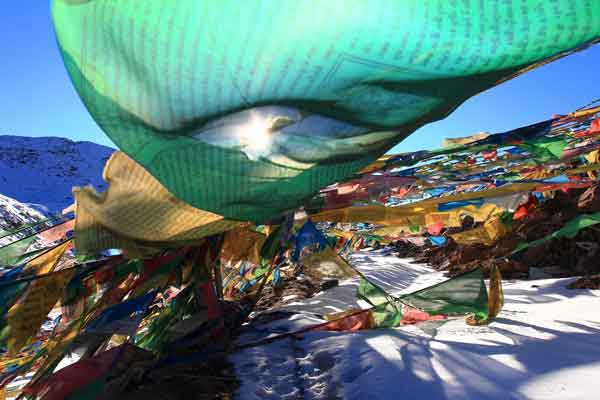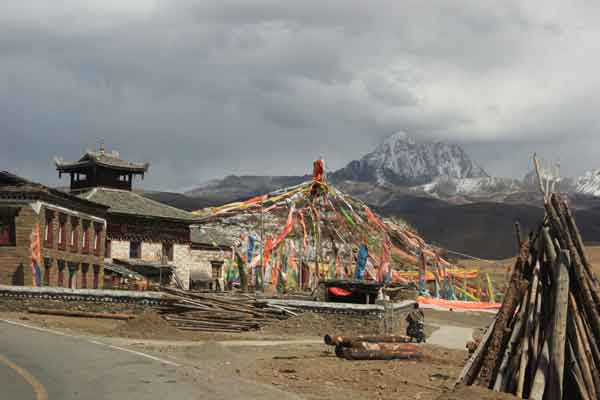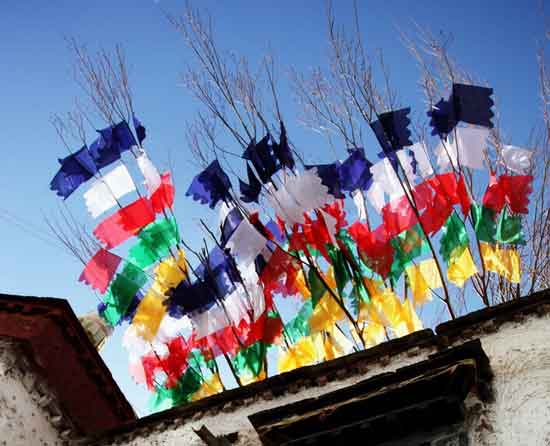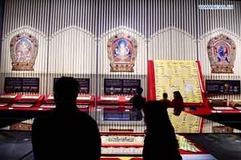Sutra streamer

Sutra streamer is one of the characteristic scenery on the plateau of Tibet that distinguishes from other places in China. The little flag with scripture and other religious semiosis on it is said to be a bond between human and God, and thus can be seen everywhere in China's Tibetan-inhabited areas, as well as neighboring areas including Nepal and India. [Photo/China Tibet Online]
Sutra streamer is one of the characteristic scenery on the plateau of Tibet that is distinctive from that of other areas in China. The little flag with scripture and other religious semiosis on it is said to be a bond between human and God, and thus can be seen everywhere in China's Tibetan-inhabited areas, as well as neighboring countriess including Nepal and India.
This Buddhist banners are painted with five colors: blue, white, red, green and yellow, which symbolize blue sky, white cloud, red flame, green water and yellow earth corresponding to the five fundamental elements of universe in Tibetan culture: water, metal, fire, wood, and earth.
These sutra flags are called "ronda" in Tibetan, and also referred to as "wind-horse flag" or "Mani flags", meaning little flag made of cloth, cambric, silk or handmade paper with scriptures printed on it, such as the six-syllable prayer and a horse carrying "Norbumopa" (a cone-shaped fire) symbolizing happiness, eminence, longevity, fortune and prosper in Tibetan culture.
The sutra flags are usually tied on the tops of Tibetan houses, temples, tents, and auspicious pillars surrounding architectures and Mani stones. Similar with the shining snow-capped mountains, refreshing plateau prairies, and glittering temples' golden roofs, sutra flag and streamer is also a distinct symbol of the natural and cultural environment of the Tibetan-inhabited areas.
Some sutra streamers are tied around a major pole rode up with "wind-horse flags". The order of these flags has to reflect the distinct trait of the host family, the temple or the blessed. For example, if the family's most senior one was born in Tibetan water year, the main flag of the sutra streamers hung on the roof of the family house should be in blue that corresponds to Tibetan Year of Water , and the following flag should be white.
In Tibetan culture, it is believed that the guardian gods of mountains and rivers on the plateau make inspection tours by horses and wind among snow mountains, forests, prairies and valleys to ward off evils and ensure the safety and peace of the tribes on the snowland.
The "wind-horse" name actually comes from the primitive sacrificial culture, which worships the souls of departed animals. Nowadays, the skulls of flocks and herds can still be seen on some Mani stone piles of various sizes.
The origin of the sutra flag is still a controversial topic between the academic circle and the religious circle, but both acknowledge that it firstly became popular in Tibetan-inhabited areas in the 12th century, when the monasteries of the Kargyu Sect of Tibetan Buddhism hang the sutra streamers unanimously in order to spread its creed.

Like many Tibetan arts, the creation and spread of "ronda" also generates from and serve for the religion, and is believed to be a medium linking the spiritual world of believers and the devine world. [Photo/China Tibet Online]

With the five colors symbolizing the five basic elements of the world, the sutra flag sacrificial activities are generally meant to pray to Buddha that all beings dominated by the five-element universe could be led by Buddha from contrariety to harmony, negative to positive, evil to kind, baleful to propitious, and unlucky to fortunate. [Photo/China Tibet Online]
Your Comment
Name E-mailRelated News
-
;
-
-

-
Sutra streamer: Symbol of Tibetan culture
The sutra streamer, a flag made of cloth, silk or handmade paper with Buddhist scriptures on it is believed to bond human and God in Tibetan culture.
-
-
-

-
Tibetan Buddhist sutra exhibited in new branch of Taipei's Palace
A long-awaited new branch of Taipei's Palace Museum was inaugurated in Chiayi city of south Taiwan on Monday.
-
-
-
Blockbusting demand for traditionally-printed Tibetan sutras
Lhasa resident Chodron has been on the waiting list for a woodblock-print sutra from her local monastery for a year, and she will need to wait another two years before she receives the beautiful piece of scripture.
-
-
-
Centuries-old Sutra printing house under repairs in Lhasa
A centuries-old Sutra printing house in Lhasa, capital of Tibet Autonomous Region in southwest China, will be closed for a year as it undergoes repairs.
-
Based in Lhasa, Tibet Vista is a Tibet travel agency that specialized in Tibet permit, and Tibet tours for both private and group travelers at a local price!
•4 Days Lhasa City Group Tour from USD 460 •8 Days Everest Base Camp Group Tour from USD 850 •15 Days Mt.Kailash Group Tour from USD 1780 •2016 Tibet Train Tours from Beijing, Shanghai, Chengdu, Xining,etc










